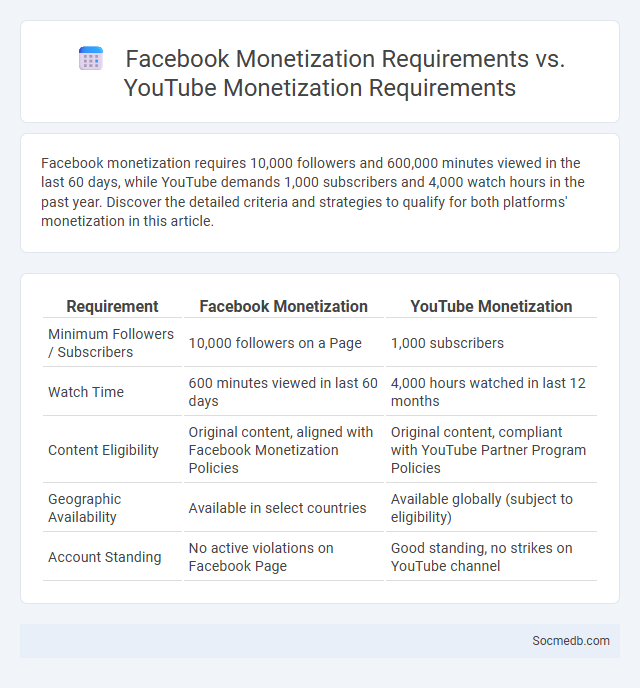
Photo illustration: Facebook Monetization Requirements vs YouTube Monetization Requirements
Facebook monetization requires 10,000 followers and 600,000 minutes viewed in the last 60 days, while YouTube demands 1,000 subscribers and 4,000 watch hours in the past year. Discover the detailed criteria and strategies to qualify for both platforms' monetization in this article.
Table of Comparison
| Requirement | Facebook Monetization | YouTube Monetization |
|---|---|---|
| Minimum Followers / Subscribers | 10,000 followers on a Page | 1,000 subscribers |
| Watch Time | 600 minutes viewed in last 60 days | 4,000 hours watched in last 12 months |
| Content Eligibility | Original content, aligned with Facebook Monetization Policies | Original content, compliant with YouTube Partner Program Policies |
| Geographic Availability | Available in select countries | Available globally (subject to eligibility) |
| Account Standing | No active violations on Facebook Page | Good standing, no strikes on YouTube channel |
Overview of Monetization on Social Media Platforms
Social media platforms generate revenue primarily through advertising, leveraging vast user data to offer targeted ads that maximize engagement and conversion rates. Influencer marketing and sponsored content have become prominent monetization avenues, allowing creators to partner with brands for mutually beneficial promotion. Subscription models, exclusive content, and virtual goods further diversify income streams, enhancing platform profitability and user experience.
Facebook Monetization Requirements: Key Criteria
Facebook monetization requirements focus on key criteria such as adhering to Facebook's Partner Monetization Policies, meeting the minimum follower count of 10,000, and accumulating at least 600,000 total minutes viewed in the last 60 days. Content creators must maintain authentic engagement, comply with community standards, and use monetization tools like in-stream ads or fan subscriptions to generate revenue. Meeting these benchmarks ensures eligibility for features like ad breaks, brand collaborations, and fan support on the platform.
YouTube Monetization Requirements: Essential Standards
YouTube monetization requires creators to meet specific criteria, including having at least 1,000 subscribers and 4,000 watch hours within the past 12 months. Channels must comply with YouTube's community guidelines and monetization policies to be eligible for the YouTube Partner Program, which allows ad revenue sharing. Verified accounts must also link to an AdSense account to receive payouts from advertisements displayed on their videos.
General Monetization Requirements Across Platforms
Social media platforms require creators to meet specific criteria for monetization, including minimum follower counts, engagement rates, and adherence to community guidelines. You must ensure your content aligns with platform policies and maintains authenticity to qualify for revenue streams like ads, sponsored posts, or fan subscriptions. These general requirements help platforms maintain quality and trust while enabling creators to generate income effectively.
Audience Size and Engagement for Monetization
Maximizing audience size on social media platforms like Instagram, TikTok, and YouTube significantly boosts monetization potential by attracting brand partnerships and ad revenues. Engagement rates, including likes, comments, shares, and video views, serve as critical metrics for influencers and creators to demonstrate audience loyalty and influence. High engagement fosters algorithmic favoritism, increasing content visibility and driving greater monetizable opportunities such as sponsorships and affiliate marketing.
Content Policies and Eligibility for Monetization
Social media platforms enforce strict content policies that prohibit harmful, misleading, or copyrighted material to maintain a safe environment and comply with legal standards. Eligibility for monetization typically requires adherence to these policies, consistent content creation, and meeting metrics like minimum follower counts or watch hours. Violations can lead to demonetization or account suspension, emphasizing the importance of compliance for sustainable revenue generation.
Monetization Tools and Features Comparison
Social media platforms offer diverse monetization tools designed to help creators and businesses generate revenue through features like ad revenue sharing, subscription models, and branded content opportunities. TikTok provides a Creator Fund and live gifting, Instagram offers Shopping and Badges, while YouTube excels with Super Chats, channel memberships, and a comprehensive Partner Program. Understanding these platform-specific monetization features allows you to select the best tools to maximize your social media income effectively.
Revenue Streams: Facebook vs YouTube
Facebook generates the majority of its revenue through targeted advertising, leveraging its vast user data to offer highly personalized ad experiences across its platforms, including Instagram and WhatsApp. YouTube's primary revenue stream is also advertising, specifically video ads displayed before, during, and after content, supplemented by YouTube Premium subscriptions and channel memberships. While Facebook's ad revenue reached approximately $115 billion in 2023, YouTube contributed over $35 billion to Google's parent company Alphabet, highlighting their dominant positions in digital advertising.
Common Challenges in Meeting Monetization Requirements
Social media platforms often face common challenges in meeting monetization requirements, including strict content guidelines that limit ad placements and reduce revenue potential. User privacy regulations such as GDPR and CCPA impose compliance costs and restrict data usage for targeted advertising, impacting monetization strategies. Furthermore, advertiser skepticism towards ad effectiveness on social media leads to fluctuating ad spend and inconsistent revenue streams.
Best Practices to Maximize Monetization Opportunities
Implement targeted content strategies that align with your audience's interests and leverage platform-specific features like Instagram Shopping or TikTok Creator Fund to maximize revenue streams. Analyze performance metrics regularly to refine your approach, focusing on high-engagement posts and optimal posting times. Collaborate with brands and utilize affiliate marketing programs to diversify Your income sources on social media.
 socmedb.com
socmedb.com